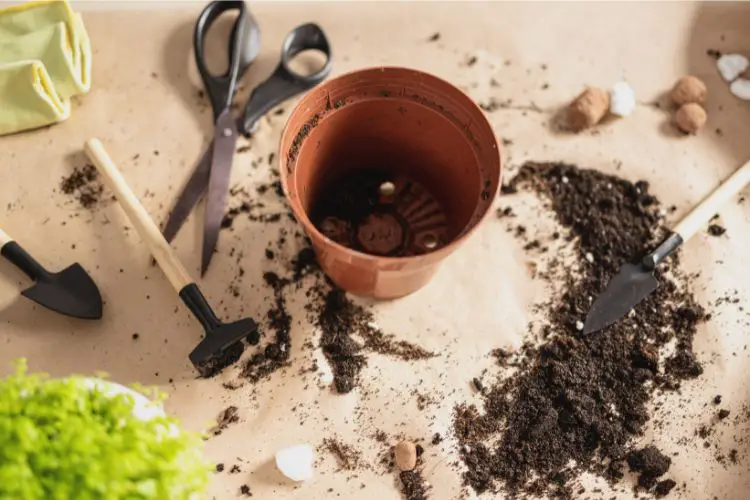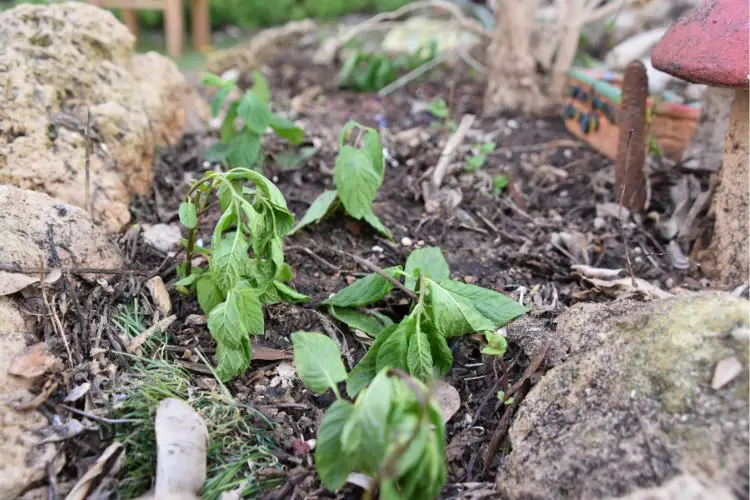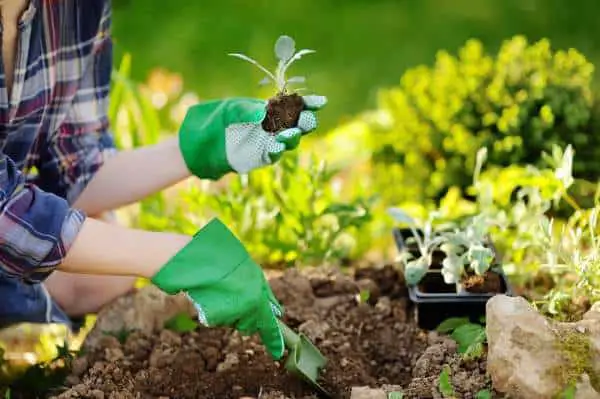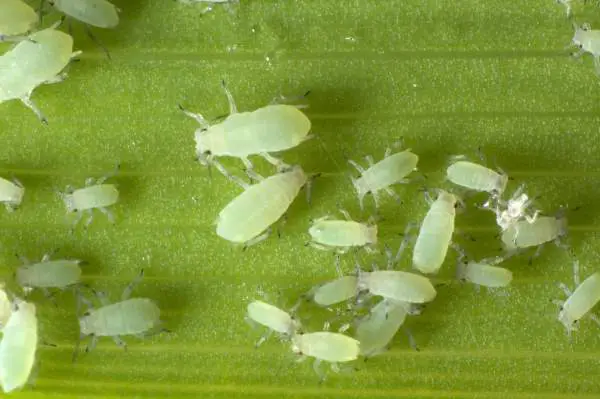Yes, you can transplant hydroponic plants to soil. However, no one says it’s easy! There are some steps you need to take to ensure that your hydroponic plants make the transition without receiving a shock to their system and suffering as a result.
This article will discuss why you might want to transfer hydroponic plants to soil, the steps to take, and some tips for transplanting your hydroponic plants.
Why Transplant Hydroponic Plants To Soil?
Soil Microbiota
The soil is a lively world of microorganisms, critical to plant health and nutrient cycling. By moving your hydroponic plants to soil, you enhance nutrient access, boost their resilience, and reduce the chances of pathogen outbreaks which are a big problem in hydroponics [1].
Hydroponics For Seed Starting and Cloning
You may want to use hydroponics for seed starting and/or cloning because hydroponic methods have faster seedling growth [2] and are cleaner. Then they can be transplanted to soil using the steps below.
Economic Considerations
Hydroponics can be cost-effective for certain crops or in certain circumstances (such as lack of outdoor space or short growing seasons). However, maintaining a hydroponic system can be expensive over time. Transplanting hydroponic plants to soil can sometimes be a more economically viable long-term option.
Space Utilization
Hydroponic systems can take up a lot of space, especially when growing larger plants. If you have more outdoor space than indoor space, you may want to transfer some or all of your hydroponic plants into a garden or field.
Sustainability
All plants need 3 resources to grow: energy, water, and nutrients.
Growing plants in soil can be more sustainable than hydroponics because it uses only the energy of the sun.
Another resource that plants need to grow and thrive is water. Hydroponics uses less water than traditional gardening in soil [3]. Even so, you still need water for circulating the nutrients, as well as periodic water changes.
If you live in an area with an abundant water supply, you can take advantage of both the sunshine and rainwater for a sustainable gardening system by planting in soil.
Soil provides most, if not all, of the nutrients plants need. These nutrients must be added to the water in hydroponic systems.
Transplanting Hydroponic Plants to Soil Step-by-Step
Here are easy-to-follow steps for transplanting a hydroponic plant into the soil.
Step 1 Reduce Water
About a week before transplanting your hydroponic plants, begin to reduce the amount of water the plants get. This will allow the plant’s roots to adapt to lower water availability in the soil environment.
Step 2 Gather The Pots

Find suitably sized pots for your plants. The larger the plant, the bigger the pot you will require. These should be roughly four to six inches wide. Plants being transplanted into the soil will need more space for their roots. Give them around four to six inches of space in the potting soil to allow them to grow.
Step 3 Fill Pots With Growing Medium
Fill each pot with a potting mix. Many growers opt for soil free peat mix but you can also use regular potting soil. The potting mix should be loose, to allow the delicate root systems to push through the mix and toughen up a bit.
Step 4 Make A Hole In The Center
Make a hole in the center of the pot, which is larger than the plant’s rooting system and the starter plug, if used. If you have plants growing together, you will need to separate the plant roots carefully as this can easily cause plant shock.
Step 5 Add Mycorrhiza
Sprinkle the hole with mycorrhiza. This beneficial fungus helps as a growth enhancer. This helps plants absorb nutrients from the soil as it helps to increase the area of absorption.
Step 6 Transfer Plants
Place the plant in the hole and then cover with additional dirt. Trim back some of the leaves. This will reduce the amount of water and nutrients the plant needs to provide to its leaves.
Step 7 Water Plants
Once you have planted, you do need to water immediately. Hydroponic plants are accustomed to being watered regularly. Sufficient watering will minimize plant shock levels they will experience.
You can use a quarter-strength nutrient solution in the beginning until they start finding their nutrients from the earth. After about a week, you can cut back on watering until you only have to water if the top inch of soil is dry.
Step 8 Harden Off Your Plants
If you’ve grown your plants indoors, they won’t be accustomed to the outside temperatures and sunlight. Start hardening off your plants by placing them outdoors for several hours. Then increase the time spent outdoors by 2 hours each day.
Transplanting Hydroponic Clones and Cuttings
While seeds are an option for gardeners, more and more gardeners are using cuttings to create clones of the original plants. Since the clones are rooted in hydroponic systems, they can be transplanted from a hydroponic system back into the soil.
The two most common hydroponics cloning systems are the domed incubation grow trays, where small Rockwool starter plugs are used, or the more complicated mist propagation systems.
Both of these systems are perfect for an outdoor garden, and can be transferred to soil once the cuttings have begun to show a good healthy rooting structure.
Cloning is a good option for propagating plants to protect the young seedlings from bad weather, as well as carry on the genetic line of a loved plant.
Also read: Indoors vs. Outdoors Hydroponics
Soil Transplanting Tips
If your plant is large, it can help to trim back some of the foliage. This pruning will help the plants, as they don’t need to search for nutrients for more leaves and can start to grow steadily.
Rockwool cubes or plugs can be planted along with the root ball directly into the soil. Planning ahead and using materials that can be buried in the soil will save you the head ache of trying to disentangle the roots without damaging them.
Net pots will be entangled with the plant’s root system if plants are more than a few weeks old. If these do need to be planted in soil, you can try planting the entire net pot along the plant. Trying to remove the intricate rooting system can kill the plant.
Transplant Shock When Moving into Soil
If you have done everything right, your plants will take hold and begin growing as they should. However, if they are suffering from shock, there are some signs you will notice. This can happen quickly or over the first couple of weeks after moving into the soil.
Leaves can turn yellow to brown and may wither up and darken. These can fall from the plant with a light touch. At this stage, leaves and stems begin to wilt and dry.

You can do some things to try and cure transplant shock, yet these may not work in every case.
- Trimming back the plant by up to one-third can help plants focus on their roots.
- Keeping the rooting systems moist is vital. But good drainage is also important to keep the roots from becoming water-logged and developing root rot.
- Add a water and sugar solution. While this isn’t 100% proven, it can help, and even if it doesn’t work, it won’t harm your plants.
Conclusion
Transplanting from a hydroponic system to a soil garden is a feasible option for many gardeners. Even if it can be a little hard for new growers, taking this route can be worth the effort. By going slowly and following the steps given above, you increase your chances of success!
References:
- Plants | Free Full-Text | The Use of PGPB to Promote Plant Hydroponic Growth (mdpi.com)
- A Simple Guide to Starting Seeds for Hydroponics – Epic Gardening
- https://extension.umn.edu/how/small-scale-hydroponics#sources-2645960





